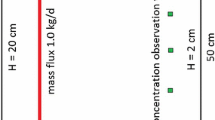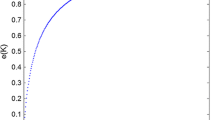Abstract
The use of inverse modeling techniques has greatly increased during the past several years because the advances in numerical modeling and increased computing power. Most of these methods require an a priori definition of the stochastic structure of conductivity (K) fields that is inferred only from K measurements. Therefore, the additional conditioning data, that implicitly integrate information not captured by K data, might lead to changes in the a priori model. Different inverse methods allow different degrees of structure adaptation to the whole set of data during the conditioning procedure. This paper illustrates the application of a powerful stochastic inverse method, the Gradual Conditioning (GC) method, to two different sets of data, both non-multiGaussian. One is based on a 2D synthetic aquifer and another on a real-complex case study, the Macrodispersion Experiment (MADE-2), site on Columbus Air Force Base in Mississippi (USA). We have analyzed how additional data change the a priori model on account of the perturbations performed when constraining stochastic simulations to data. Results show how the GC method tends to honour the a priori model in the synthetic case, showing fluctuations around it for the different simulated fields. However, in the 3D real case study, it is shown how the a priori structure is slightly modified not obeying just to fluctuations but possibly to the effect of the additional information on K, implicit in piezometric and concentration data. We conclude that implementing inversion methods able to yield a posteriori structure that incorporate more data might be of great importance in real cases in order to reduce uncertainty and to deal with risk assessment projects.







Similar content being viewed by others
References
Abolverdi J, Khalili D (2010) Development of regional rainfall annual maxima for Southwestern Iran by LMoments. Water Resour Manag 24(11):2501–2526
Adams EE, Gelhar LW (1992) Field study of dispersion in a heterogeneous aquifer 2. Spatial moments analysis. Water Resour Res 28(12):3293–3307
Boggs JM, Adams EE (1992) Field study of dispersion in a heterogeneous aquifer. 4. Investigation of adsorption and sampling bias. Water Resour Res 28(12):3325–3336
Boggs JM, Young SC, Beard LM (1992) Field study of dispersion in a heterogeneous aquifer. 1. Overview and site description. Water Resour Res 28(12):3281–3291
Caers J (2007) Comparing the gradual deformation with the probability perturbation method for solving inverse problems. Math Geol 39(1). doi:10.1007/s11004-006-9064-6
Capilla JE, Llopis-Albert C (2009) Gradual conditioning of non-Gaussian transmissivity fields to flow and mass transport data: 1. Theory. J Hydrol 371:66–74
Carrera J, Alcolea A, Medina A, Hidalgo J, Slooten LJ (2005) Inverse problem in hydrogeology. J Hydrogeol 13:206–222
Charalambous J, Rahman A, Carroll D (2013) Application of Monte Carlo simulation technique to design flood estimation: a case study for North Johnstone River in Queensland, Australia. Water Resour Manag 27:4099–4111. doi:10.1007/s11269-013-0398-9
De Marsily G, Delhomme JP, Coudrain-Ribstein A, Lavenue AM (2000) Four decades of inverse problems in hydrogeology. Geol Soc Am (Special Paper 348)
Doherty J (1994) PEST: Corinda, Australia. Watermark Computing, 122 p
Gómez-Hernández JJ, Srivastava RM (1990) ISIM3D: An ANSI-C three dimensional multiple indicator conditional simulation program. Comput Geosci 16(4):395–440
Gómez-Hernández JJ, Wen XH (1998) To be or not to be multiGaussian? A reflection on stochastic hydrogeology. Adv Water Resour 21(1):47–61
Gómez-Hernández JJ, Sahuquillo A, Capilla JE (1997) Stochastic simulation of transmissivity fields conditional to both transmissivity and piezometric data. 1. Theory. J Hydrol 203:162–174
Hu LY (2000) Gradual deformation and iterative calibration of gaussian-related stochastic models. Math Geol 32(1):87–108
Llopis-Albert C, Capilla JE (2009a) Gradual conditioning of non-gaussian transmissivity fields to flow and mass transport Data: 3. Application to the Macrodispersion experiment (MADE-2) site, on Columbus air force base in Mississippi (USA). J Hydrol 371:75–84
Llopis-Albert C, Capilla JE (2009b) Gradual conditioning of non-Gaussian transmissivity fields to flow and mass transport data: 2. Demonstration on a synthetic aquifer. J Hydrol 371:53–65
Llopis-Albert C, Capilla JE (2010a) Stochastic inverse modeling of hydraulic conductivity fields taking into account independent stochastic structures: a 3D case study. J Hydrol 391:277–288
Llopis-Albert C, Capilla JE (2010b) Stochastic simulation of non-Gaussian 3D conductivity fields in a fractured medium with multiple statistical populations: a case study. J Hydrol Eng 15(7):554–566
Llopis-Albert C., Capilla JE (2011) Change of the a priori stochastic structure in the conditional simulation of transmissivity fields. P.M. Atkinson and C.D. Lloyd (eds.), geoENV VII – Geostatistics for Environmental Applications, Quant Geol Geostat 16. Springer. ISBN: 9048123216
Llopis-Albert C, Palacios-Marqués D, Merigó JM (2014) A coupled stochastic inverse-management framework for dealing with nonpoint agriculture pollution under groundwater parameter uncertainty. J Hydrol 511:10–16. doi:10.1016/j.jhydrol.2014.01.021
McLaughlin D, Townley LR (1996) A reassessment of the groundwater inverse problem. Water Resour Res 32(5):1131–1161
Mylopoulos YA, Theodosiou N, Mylopoulos NA (1999) A stochastic optimization approach in the design of an aquifer remediation under Hydrogeologic uncertainty. Water Resour Manag 13(5):335–351
Neupauer RM, Wilson JL (1999) Adjoint method for obtaining backward-in-time location and travel time probabilities of a conservative groundwater contaminant. Water Resour Res 35(11):3389–3398
Oliver DS, Chen Y (2010) Recent progress on reservoir history matching: a review. Comput Geosci 15(1):185–221
Poeter EP, Hill MC (1998) Documentation of UCODE, a computer code for universal inverse modeling. US Geol Surv Water Resour Investig Rep 98–4080:116
Rehfeldt KR, Boggs JM, Gelhar LW (1992) Field study of dispersion in a heterogeneous aquifer 3. Geostatistical analysis of hydraulic conductivity. Water Resour Res 28(12):3309–3324
Salamon P, Fernández-Garcia D, Gómez-Hernández JJ (2007) Modeling tracer transport at the MADE site: the importance of heterogeneity. Water Resour Res 43:W08404. doi:10.1029/2006WR005522
Vázquez RF, Beven K, Feyen J (2009) GLUE based assessment on the overall predictions of a MIKE SHE application. Water Resour Manag 23:1325–1349. doi:10.1007/s11269-008-9329-6
Yeh WWG (1986) Review of parameter identification procedures in groundwater hydrology: the inverse problem. Water Resour Res 22(2):95–108
Zakaria ZA, Shabri A, Ahmad UN (2012) Regional frequency analysis of extreme rainfalls in the West Coast of Peninsular Malaysia using partial L-Moments. Water Resour Manag 26(15):4417–4433
Zheng C, Bianchi M, Gorelick SM (2011) Lessons learned from 25 years of research at the MADE Site. Groundw 49(5):649–662
Zhou H, Gómez-Hernández JJ, Li L (2014) Inverse methods in hydrogeology: evolution and recent trends. Adv Water Resour 63:22–37. doi:10.1016/j.advwatres.2013.10.014
Zimmerman DA et al (1998) A comparison of seven geostatistically based inverse approaches to estimate transmissivities for modeling advective transport by groundwater flow. Water Resour Res 34(6):1373–1413
Author information
Authors and Affiliations
Corresponding author
Rights and permissions
About this article
Cite this article
Llopis-Albert, C., Merigó, J.M. & Palacios-Marqués, D. Structure Adaptation in Stochastic Inverse Methods for Integrating Information. Water Resour Manage 29, 95–107 (2015). https://doi.org/10.1007/s11269-014-0829-2
Received:
Accepted:
Published:
Issue Date:
DOI: https://doi.org/10.1007/s11269-014-0829-2




